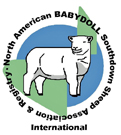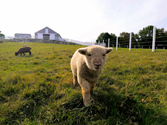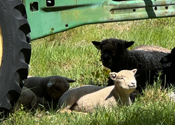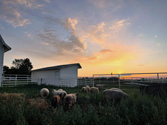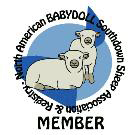If you're looking for a renewable, natural fiber with the following qualities:
- biodegradable, eco-friendly
- easy care, resists soiling
- flame resistant
- moisture absorbing by being able to wick away up to 30% of its own weight
- multi-season because it insulates and breathes
- resilient because it retains its shape, resists wrinkling and stretches
- water repellent products
your Babydolls can provide it.
Bergamascos' Babydoll Brigade was home to my flock ranging from fifteen to thirty sheep. The wool from the sheep was harvested annually using the process known as shearing. I had my sheep sheared by a professional shearer. The wool from the sheep is a hardened protein and does not contain any sensory structures. Wool is similar in its chemical composition to human hair and fingernails. Contrary to what some may think, removing the wool via shearing does not cause the sheep to "feel" any pain. When the wool is sheared it is similar to when humans have their hair cut or a have a manicure.
Once the sheep have been sheared, their fleeces are scoured and processed into batts, roving, and yarn which I transform into handmade items such as dryer balls, knitted hats, sweater, socks, afghans, baskets, rugs, and more. My mother uses needle felted Babydoll batts in her quilts.
There are very few people allergic to wool. The chemical make-up of wool is similar to the chemical make-up of fingernails and hair. If you're not allergic to fingernails and hair, you're probably not allergic to wool. Your "allergy" is most likely the reaction to fiber with a micron count greater than 30. These fibers are structurally rigid enough to cause "poking" of the skin and elicit a response from the sensory receptors similar to an allergic reaction. Some people have more sensitive skin than others. Most Babydoll Southdowns have a micron count ranging from 23 to 29 inches which means the majority of people can wear it comfortably next to the skin.
Hip, hip, hooray for the Babydoll - a down breed!
Down breeds, such as the Babydoll, are a dual purpose sheep. In other words, they are used for both wool and meat. Some even milk them. The wool aspect seems to be lost on many folks because the wool is not what they are used to with the longwools or the fine wools.
The true down breeds are called “Down” because they originated in England in the southwestern region and not because they have a downy undercoat.
The wool from the Babydoll, as well as the other down breeds, is generally lacking luster and the locks are not well defined. The crimp may not be as obvious as it is with other wool categories. There is plenty of crimp in each fiber though; however, it is spiral in nature not just kinked. This means the fibers are separate and don’t just nest next to each other. This feature traps air in the spaces making the wool highly insulating; thus very warm.
The spiral crimp of the down breeds also makes it resistant to felting, but not immune to felting. It can be needle felted but at the same time can be thought of as a natural superwash. It is perfect for socks and other items needing frequent washing. I wash all of my knitted items in hot water with a regular load of laundry in my front loading machine. I have never used a top loader so cannot personally say what the washed results would be. Once out of the wash, I give them a gentle lengthwise tug to reshape them and let them air dry. Do not machine wash an item with fringe.
The fineness of the down breeds has a fairly broad range. Most fall into the middle range but several produce very fine soft fleeces. My flock's wool was evaluated in 2014, 2017, 2018, & 2020. In 2014, I had twelve of my off-white sheep’s wool tested. The average micron count was 25.9 with the lowest being 23.0 and the highest being 27.9. I also had five black sheep’s wool tested. The average micron count was 27.2 with the lowest being 26.0 and the highest being 30.4. 2017's testing, the average micron count was 27.6 with the lowest being 21.8 and the highest being 35.1. 2018's testing, the average micron count was 26.4, with the lowest being 21.9 and the highest being 33.4. 2020's testing, the average micron count is 29.0 with the lowest being 24.0 and the highest being 35.6.
If you want to have your flock tested, wool samples should be taken from the mid-side of the sheep, a standard location defined as being centered on the third-to-last rib, halfway between the top of the back and the belly. Cut the sample close to the skin and ensure it includes the full staple length. For some tests, a minimum sample size (e.g., 30 grams) is required. I used Bill Sims Wool and Mohair Research Laboratory located at Texas A&M.It is a widely spread rumor, in my opinion, that the Babydoll’s wool is in the cashmere range. None of the sheep's fleeces I've had tested met the required not to exceed 19 microns and I do not think any of the other Babydoll breeders who've had their tested tested in the cashmere range either. According to Wikipedia...
In the United States, under the U.S. Wool Products Labeling Act of 1939, as amended, (15 U. S. Code Section 68b(a)(6)), states that a wool or textile product may be labeled as containing cashmere only if: such wool product is the fine (dehaired) undercoat fibers produced by a cashmere goat (Capra hircus laniger); the average diameter of the fiber of such wool product does not exceed 19 microns; and such wool product does not contain more than 3 percent (by weight) of cashmere fibers with average diameters that exceed 30 microns. The average fiber diameter may be subject to a coefficient of variation around the mean that shall not exceed 24 percent.
Preparation of the Babydoll wool, and other down breeds, will depend on the fiber length. When a sample is sent to a lab to be tested, the sample is sheared from the side of the sheep at the last rib 1/2 way between the top of the sheep and the belly of the sheep. The fleece is generally shorter here than the longer neck area wool. Of course, this neck area also tends to be the area full of the most vegetable matter (VM). The average staple length, in 2014, of twelve of my off-whites was 1.42", the longest being 2.56" and the shortest being 0.91". The average staple length of five of my black Babydolls was 1.55", the longest being 1.97" and the shortest being 1.18". Most of the sheep I tested had fourteen months growth on them. In 2017, the average staple length of nineteen of my Babydolls was 2.34" for one year's growth. In 2018, the average staple length of twenty-one of my Babydolls was 1.97" for a one year's growth. In 2020, the average staple length for twenty-one of my Babydolls is 2.05".
Regardless of the staple length, I've processed all of my sheep's fleeces, even the 0.94 inches staple length sheep, hand spun some very nice yarn and made very nice hand made products. When I was selling my fleeces, I had a customer return some scoured fleece she bought from me because, I feel, she based her expectations of the Babydoll fleece on what is “put out there on the Internet”. I do state on my website, in more than one place, I have found the statistics to be incorrect based on my flock and the experience of other Babydoll owners.
Quoted from the customer's e-mail to me - “I have been a spinner and flock owner for 20+ years. I am very disappointed with the wool I received from you. I like the softness of the fleece. However, the staple length was said to be 2.5 to 4 inches in length. Whereas there are some pieces that are of that length there is much that must be second cuts...because it is VERY SHORT! This should have been skirted out. For the price I paid, I expected better. If this was my fleece, much of it would have been discarded or used for felting. My intention was to spin this fleece.”
If one is used to working with longer staple length fibers, getting used to and making the Babydoll wool do what you want it to is going to take some practice. Please don't judge it simply on the staple length. I've since turned those "very short, second cuts" the above customer returned to me into gorgeous yarn. Some of the yarns I've spun from from my flock can be seen in the photo below.
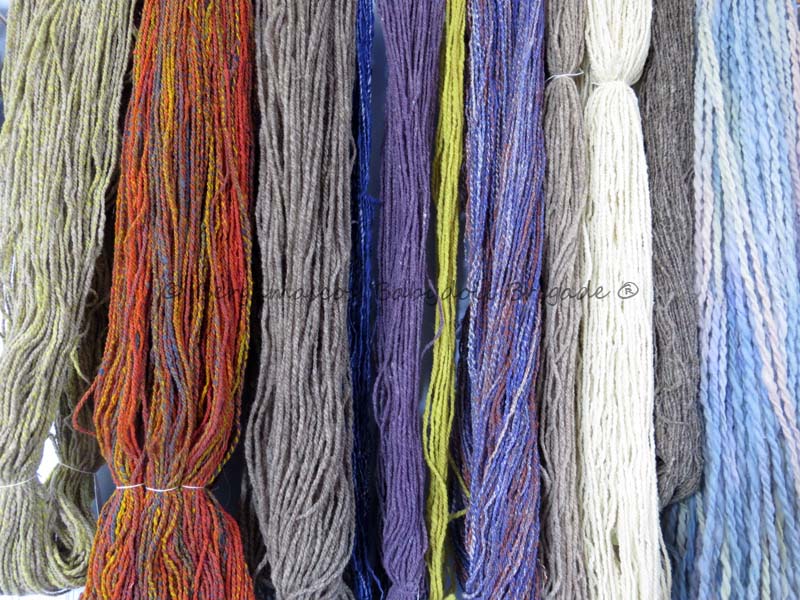
The Babydoll is a dual-purpose breed and historically their wool was highly prized. Their wool is unique. It has a short staple compared to the more popular breeds' wool usually used for spinning. It is very elastic, is extremely lofty, and doesn't wet felt as easily as other wool. If one can get past their preconceived notions about the Babydoll wool, they find it can be easy to spin. Because of the very dense physical properties of the Babydoll Southdown wool, it produces a product with a ton of cushion, bounce, elasticity, softness, and durability. Although I am partial to my Babydoll breed - I only work with their fiber, because the Babydoll fiber has more barbs per inch than other wool types, it blends well with other fibers too.
If interested in
seeing many of the items I've made from 100% Babydoll wool over the
years, my facebook page dedicated to my flock of Babydolls has albums titled My Babydoll
Southdown projects showcasing all the years of my
work from 2013 to the present. There are pictures and many of
them include information on the processes I used for making them.
Information above from my general knowledge of my breed and the American Sheep Industry Association
